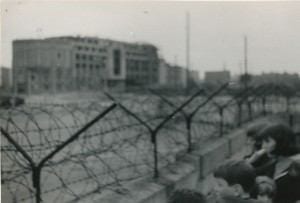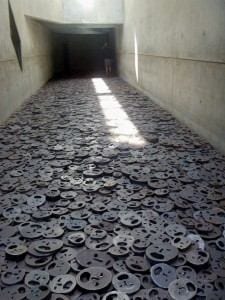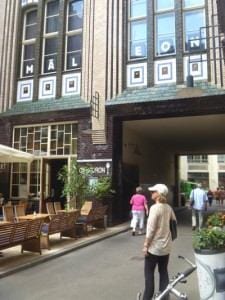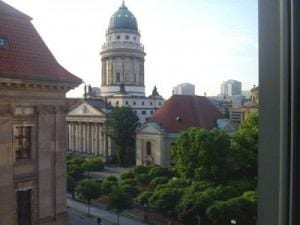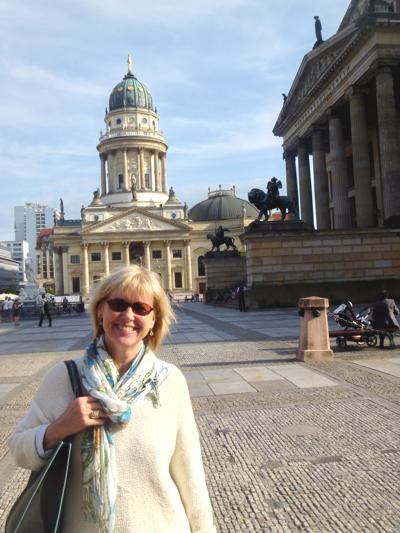 When you travel back to a city you call home, often see it with fresh eyes. This happened to Alexandra (Sandy) Gleysteen, the senior producer for CBS This Morning. The daughter of a former American diplomat, who moved his family to Berlin in 1962, she left the city 1966, but continued her love for Germany with a stint at the German School outside Washington, DC, and with as many trips back to Europe as she could manage over the years. She shared this report about her most recent trip to Berlin — her first in nearly a quarter century.
When you travel back to a city you call home, often see it with fresh eyes. This happened to Alexandra (Sandy) Gleysteen, the senior producer for CBS This Morning. The daughter of a former American diplomat, who moved his family to Berlin in 1962, she left the city 1966, but continued her love for Germany with a stint at the German School outside Washington, DC, and with as many trips back to Europe as she could manage over the years. She shared this report about her most recent trip to Berlin — her first in nearly a quarter century.
It’s been almost 25 years since the Berlin Wall fell in 1989, but “die Mauer” remains a tangible and defining part of this city’s character. Germans rushed to tear it down when reunification became a possibility, the Wall too obvious a symbol of the country’s painful division. But the fact remains, that the scars of that wall are still around, and felt especially by those of us old enough to have a history in Berlin.
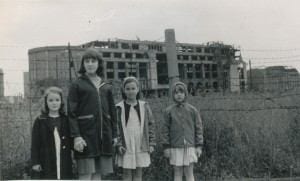
Sandy is second from the right with a headband, standing with a cousin visiting from the USA and her sister
My family moved to Berlin at an emotional time in the city’s story. The Wall was built in 1961, ostensibly to keep Soviet ideology free of capitalist and fascist influence. We came in 1962. Feelings were still raw, intensely so. Neighbors told us about the day the roads and subways closed, suddenly and permanently separating them from family and property in the East.
Strangely, the wall became the tourist destination to the many Americans who came to visit us over the next four years. But for our German neighbors and friends, it was a symbol of personal loss and the public humiliation associated with World War II.
There was something surreal about growing up in Berlin. Our school expeditions included walks along the river Spree. As we skipped along on one side of the river, we watched the guards patrolling on the eastern side, their guns slung menacingly over their shoulders. As a family with diplomatic privilege, we were free to come and go between East and West; sometimes to visit the Pergamon Museum, often just to picnic along one of the lakes in the East. As children we were both acutely aware that something wasn’t right, but simultaneously oblivious to the reality of what was at stake. I definitely remember Berlin as a city of tension.
Returning today, you have to look to find the physical remnants of the Berlin Wall. With the exception of a very short stretch, it’s simply vanished. Checkpoint Charlie has become a tourist destination, and a disappointing one at that, given there is truly not much to see.
Berlin is less elegant than it is vibrant. It’s still possible to recognize what was once the East, if for no other reason than that much of the ugly Soviet architecture stands out. And where pre-war buildings have survived, some are still pockmarked by artillery shells. But all in all, 24 years after the fall of the Wall, the city feels pretty integrated, and it’s hard to imagine that there was a time you couldn’t cross over the Fridrichsstrasse without passports and armed guards—and then only if you were not German.
While the Wall is largely no longer visible, it cannot completely escape its legacy. Berlin feels like a city in a state of perpetual self-examination and re-creation. Everywhere you look, there are cranes looming—either restoring the old– or building something new. After years of being exiled from the rest of Germany, Berlin once again became the country’s capital after the fall of the Wall. The new government needed a new home. It built the modern Reichstag right into the old one in an incredible job of architectural fusion. The views of Berlin from the magnificent glass dome are spectacular, explaining why it is the second most visited attraction in Germany.
To get an insight into the darker aspects of Berlin and Germany’s past, there are at least two must-see museums. One is the Topography of Terror in the Niederkirchnerstrasse. Built adjacent to the old SS and Gestapo headquarters– and behind a lonely remnant of the Wall–this museum offers a brutally honest look at the role Germany played in its rise to fascism and into the Nazi era. In the present exhibition, Zwischen den Zeilen, the photographs shocked even those of us who thought we’d seen it all. I was with friends who, like me, found it difficult to process some of the exhibits. Goebbels, Goerring, Mengele, Hess—most of the Nazi’s top leadership are captured in photographs, laughing, smoking and chatting in the foreground, no care in the world, as emaciated Jews work in the camps or are executed in the background. You can’t help but wonder whether other cultures would be as willing as the Germans to air their dirtiest linen in so public a manner. But this is a culture that has been forced to, and been willing to, confront its past.
The other must-see museum is the Jewish Museum, designed by architect Daniel Libeskind. It’s focused on telling the story of the Jews throughout history, not just of their brutal treatment under the Nazis. But there is poignancy in having this museum stand in the very heart of Hitler’s Third Reich. The son of Holocaust survivors, Libeskind designed a building that is as much a visceral experience as a place to exhibit artifacts and art. It’s an eerie monument, a testament to the power of architecture to evoke emotion. A walk through the Garden of Exile leaves you completely disoriented and off balance. Go when you have the time to appreciate it. It’s not a museum to jam into a busy day.
Our original plan was to stay at the legendary Adlon Hotel right next to the Brandenburg Gate. But an online search several months before the trip landed us an incredible deal at the Regent Hotel off the Gendarmenmarkt. The Regent also turned out to be a perfect location from which to discover old East Berlin. We could get to most places by foot—the Museuminsel with all its museums, the Brandenburg Gate, the famous street Unter den Linden. And what we couldn’t get to on foot, we reached with public transportation.
The street car and underground stations are all over the city and only a block from the hotel. (It’s worth investing in the six Euro day ticket if you plan on going to more than one location.) And we really lucked out because the General Manager, Stefan Athmann, also happened to be one of the best connected people in Berlin. He’s a living, breathing rolodex of all the right galleries, sites and restaurants in town — the ones NOT in the guide books, but the ones that you must experience.
For example, Berlin’s most famous shopping might be at KaDeWe on Kurfurstendamm, but the coolest shopping is the area in the old East around the Hackesche Hofe, a charming art nouveau courtyard complex. Its eight interconnected courtyards are lined with little boutiques showcasing the crafts and fashions of local designers and artists. Not a Benetton, Zara or Gap in sight! And right outside the entrance to the courtyards is the Hackesche Market, filled with good cafes and restaurants… and tons of shopping all around the area. My friends told me the Euro would go further in the old East, and while I have no proof of that, it did feel as if the bargains were better and the restaurants a little bit less expensive.
There were places I didn’t get to on this visit, places I have remembered as special from my childhood: the family picnics to the Pfaueninsel (Peacock Island), school trips to Charlottenburg Palace, bike rides through the Gruenewald. But they were all places in the West, and this trip was about the East. Perhaps the most astonishing discovery was how the two sides have melded and integrated over the past 24 years, yet still maintained their distinct characters. But with time, my guess is, those will be less noticeable as well.
Meanwhile, Berlin is a pulsing, exciting city, one perhaps that will forever be engaged in the act of redefining itself. Sitting in the heart of Europe, it’s a great vantage point to observe its post-Cold War evolution, with its waves of immigrants coming in to now leave their mark on the city. One of its former mayors called Berlin “poor, but sexy,” and if sexy includes gritty, exciting, and elegant all in one, I would have to concur. As my parents used to tell us about great experiences and places in the world, “run, don’t walk.” That, ultimately, is my advice about a visit to Berlin.
For another historic look at Berlin, don’t miss, Revisiting the Berlin Wall 20 Years Later.
By Alexandra Gleysteen for PeterGreenberg.com










